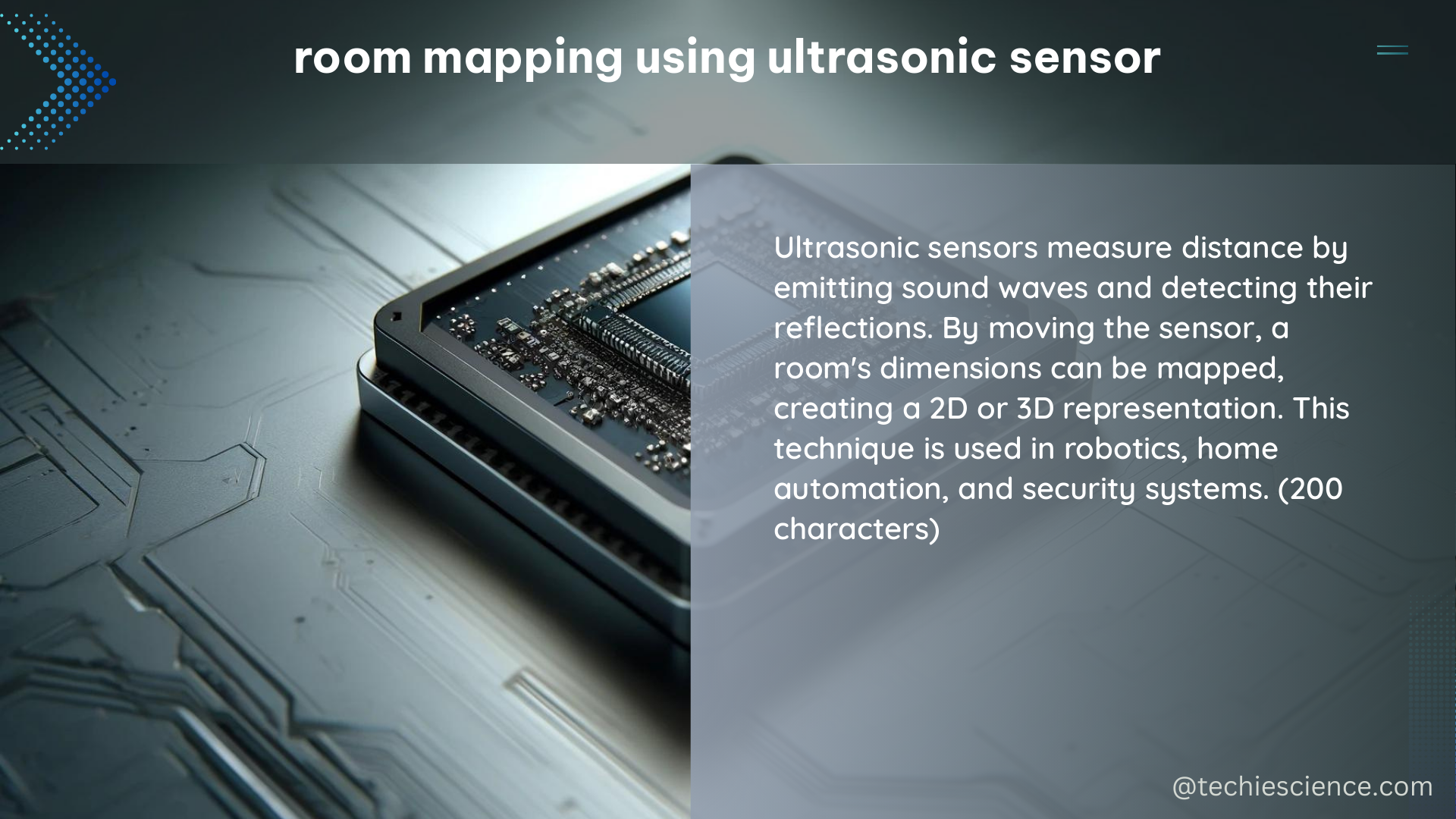Room mapping using ultrasonic sensors is a powerful technique that leverages high-frequency sound waves to measure the distance between the sensor and objects within a defined space. This technology finds widespread applications in robotics, automation, and workplace safety, enabling the monitoring of object positions and movements with precision.
Understanding the Fundamentals of Ultrasonic Sensors
Ultrasonic sensors work by emitting high-frequency sound waves, typically in the range of 40 kHz to 400 kHz, and measuring the time it takes for the waves to reflect off nearby objects and return to the sensor. This time-of-flight (ToF) measurement can be converted into a distance calculation using the known speed of sound in air, which is approximately 343 meters per second at room temperature.
The accuracy of the distance measurement depends on various factors, including:
- Angle of Incidence: The angle at which the sound wave strikes the object can affect the reflection and, consequently, the distance measurement.
- Object Size and Shape: Larger, flatter objects tend to provide better reflections, while smaller or irregularly shaped objects may result in less accurate measurements.
- Environmental Conditions: Factors such as temperature, humidity, and air pressure can influence the speed of sound and, therefore, the distance calculation.
- Interference: The presence of other objects or obstacles in the room can cause interference and affect the sensor’s ability to accurately detect and measure the target object.
Implementing Room Mapping with Ultrasonic Sensors

To create a comprehensive room map using ultrasonic sensors, several key considerations must be addressed:
Sensor Placement and Coverage
The number and placement of ultrasonic sensors within the room are crucial for achieving optimal coverage and accuracy. Factors to consider include:
- Room Size and Layout: Larger rooms may require more sensors to ensure complete coverage, while the room’s shape and obstacles can influence the optimal sensor placement.
- Sensor Range: Ultrasonic sensors typically have a maximum range of several meters, depending on the specific model. Ensure that the sensors can cover the entire room effectively.
- Sensor Orientation: Strategically orienting the sensors can help minimize the impact of angle of incidence and improve the accuracy of distance measurements.
Sensor Synchronization and Data Integration
To create a cohesive room map, the data from multiple ultrasonic sensors must be synchronized and integrated. This can be achieved through the use of a central control system or microcontroller that collects and processes the sensor data. Techniques such as sensor fusion and data interpolation can be employed to enhance the accuracy and resolution of the room map.
Mapping Algorithms and Data Visualization
The raw distance measurements from the ultrasonic sensors can be processed using various mapping algorithms to generate a detailed representation of the room and the objects within it. These algorithms may include:
- Occupancy Grid Mapping: Dividing the room into a grid of cells and tracking the occupancy status of each cell based on the sensor data.
- Probabilistic Mapping: Utilizing probabilistic models to estimate the likelihood of object presence and location within the room.
- Feature-based Mapping: Identifying and tracking specific features or landmarks within the room to build a more detailed map.
The resulting room map can be visualized using a variety of tools, such as 2D or 3D graphical representations, heat maps, or augmented reality overlays, depending on the specific application requirements.
Practical Considerations and Optimization
When implementing room mapping using ultrasonic sensors, several practical considerations and optimization techniques should be taken into account:
Sensor Selection and Calibration
Choosing the right ultrasonic sensor for the application is crucial. Factors to consider include the sensor’s range, accuracy, resolution, and frequency response. Proper calibration of the sensors is also essential to ensure accurate distance measurements.
Environmental Compensation
To mitigate the effects of environmental factors, such as temperature and humidity, on the speed of sound, compensation algorithms can be implemented. This may involve incorporating additional sensors or using lookup tables to adjust the distance calculations accordingly.
Sensor Fusion and Data Fusion
Combining data from multiple ultrasonic sensors, as well as other types of sensors (e.g., infrared, laser, or vision-based), can improve the overall accuracy and reliability of the room mapping system. Techniques like Kalman filtering or sensor fusion algorithms can be employed to integrate and fuse the sensor data effectively.
Real-time Performance and Computational Efficiency
Depending on the application, the room mapping system may need to operate in real-time, requiring efficient data processing and decision-making algorithms. Optimizing the computational resources, such as using microcontrollers or embedded systems, can be crucial for achieving the desired performance and responsiveness.
Conclusion
Room mapping using ultrasonic sensors is a versatile and powerful technique that enables the precise monitoring and tracking of objects within a defined space. By understanding the fundamental principles, implementation considerations, and optimization strategies, you can develop robust and reliable room mapping systems for a wide range of applications, from robotics and automation to workplace safety and beyond.
Reference:
- Ultrasonic Sensor Basics
- Ultrasonic Ranging Sensors
- Ultrasonic Sensor Applications in Robotics
- Ultrasonic Sensor Technology and Its Applications
- Ultrasonic Sensor Characteristics and Applications

The lambdageeks.com Core SME Team is a group of experienced subject matter experts from diverse scientific and technical fields including Physics, Chemistry, Technology,Electronics & Electrical Engineering, Automotive, Mechanical Engineering. Our team collaborates to create high-quality, well-researched articles on a wide range of science and technology topics for the lambdageeks.com website.
All Our Senior SME are having more than 7 Years of experience in the respective fields . They are either Working Industry Professionals or assocaited With different Universities. Refer Our Authors Page to get to know About our Core SMEs.